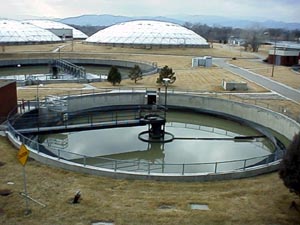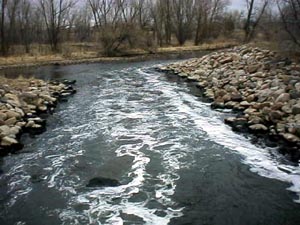 The
wastewater from Boulder's houses and businesses travels through
the sewer system to the Boulder Wastewater Treatment Plant, located
on 75th Street. The Boulder WWTP treats an average of 17 million
gallons of wastewater per day using a 10-hour, multi-stage cleaning
process involving biologic and chemical treatments. Industrial
businesses are required to meet City discharge limits and may
need to pre-treat their wastes prior to discharge into the City's
sewer system (see the
City of Boulder's Industrial Pretreatment website for more information).
Chemicals used in the home can also affect water quality and should
not be disposed through the sewer system but through a hazardous
waste collection program (see
Boulder County's Household Hazardous Waste Website for more information).
There are many alternatives
to household cleaners that are less hazardous and do not need
special handling.
The
wastewater from Boulder's houses and businesses travels through
the sewer system to the Boulder Wastewater Treatment Plant, located
on 75th Street. The Boulder WWTP treats an average of 17 million
gallons of wastewater per day using a 10-hour, multi-stage cleaning
process involving biologic and chemical treatments. Industrial
businesses are required to meet City discharge limits and may
need to pre-treat their wastes prior to discharge into the City's
sewer system (see the
City of Boulder's Industrial Pretreatment website for more information).
Chemicals used in the home can also affect water quality and should
not be disposed through the sewer system but through a hazardous
waste collection program (see
Boulder County's Household Hazardous Waste Website for more information).
There are many alternatives
to household cleaners that are less hazardous and do not need
special handling.
 When wastewater from our sewers reach the WWTP, coarse debris,
such as twigs and rags, is first removed from the waste stream
by bar screens. Inorganic materials, including sand and grit,
are then removed in aerated grit chambers. The wastewater then
flows into primary settling tanks. This process removes total
suspended solids (TSS)
along with organic material. The wastewater then passes through
a trickling filter process that removes dissolved organics. Microorganisms
growing on rock media in the trickling filters use organic matter
in the waste as a food source, converting these materials into
biomass and carbon dioxide. The biomass is removed from the wastewater
and treated. Part of the wastewater is then pumped to the nitrifying
trickling filter (NTF). Nitrifying bacteria growing on the NTF
plastic media convert ammonia
(which can be toxic to aquatic life) to nitrate.
This stream is then blended with the rest of the wastewater and
treated with chlorine to remove pathogens. Since chlorine can
be very toxic to fish, the chlorine remaining after disinfection
is destroyed by adding sulfur dioxide to the treated wastewater.
The dechlorinated water is then discharged to Boulder Creek (just
above 75th Street, east of Boulder) in accordance with regulations
contained in the city's discharge permit issued by the Colorado
Department of Public Health & Environment (CDPHE). (Excerpted
from the City
of Boulder's Public Works-Utilities-Water Website)
When wastewater from our sewers reach the WWTP, coarse debris,
such as twigs and rags, is first removed from the waste stream
by bar screens. Inorganic materials, including sand and grit,
are then removed in aerated grit chambers. The wastewater then
flows into primary settling tanks. This process removes total
suspended solids (TSS)
along with organic material. The wastewater then passes through
a trickling filter process that removes dissolved organics. Microorganisms
growing on rock media in the trickling filters use organic matter
in the waste as a food source, converting these materials into
biomass and carbon dioxide. The biomass is removed from the wastewater
and treated. Part of the wastewater is then pumped to the nitrifying
trickling filter (NTF). Nitrifying bacteria growing on the NTF
plastic media convert ammonia
(which can be toxic to aquatic life) to nitrate.
This stream is then blended with the rest of the wastewater and
treated with chlorine to remove pathogens. Since chlorine can
be very toxic to fish, the chlorine remaining after disinfection
is destroyed by adding sulfur dioxide to the treated wastewater.
The dechlorinated water is then discharged to Boulder Creek (just
above 75th Street, east of Boulder) in accordance with regulations
contained in the city's discharge permit issued by the Colorado
Department of Public Health & Environment (CDPHE). (Excerpted
from the City
of Boulder's Public Works-Utilities-Water Website)

 The
wastewater from Boulder's houses and businesses travels through
the sewer system to the Boulder Wastewater Treatment Plant, located
on 75th Street. The Boulder WWTP treats an average of 17 million
gallons of wastewater per day using a 10-hour, multi-stage cleaning
process involving biologic and chemical treatments. Industrial
businesses are required to meet City discharge limits and may
need to pre-treat their wastes prior to discharge into the City's
sewer system (see the
The
wastewater from Boulder's houses and businesses travels through
the sewer system to the Boulder Wastewater Treatment Plant, located
on 75th Street. The Boulder WWTP treats an average of 17 million
gallons of wastewater per day using a 10-hour, multi-stage cleaning
process involving biologic and chemical treatments. Industrial
businesses are required to meet City discharge limits and may
need to pre-treat their wastes prior to discharge into the City's
sewer system (see the  When wastewater from our sewers reach the WWTP, coarse debris,
such as twigs and rags, is first removed from the waste stream
by bar screens. Inorganic materials, including sand and grit,
are then removed in aerated grit chambers. The wastewater then
flows into primary settling tanks. This process removes total
suspended solids (
When wastewater from our sewers reach the WWTP, coarse debris,
such as twigs and rags, is first removed from the waste stream
by bar screens. Inorganic materials, including sand and grit,
are then removed in aerated grit chambers. The wastewater then
flows into primary settling tanks. This process removes total
suspended solids (